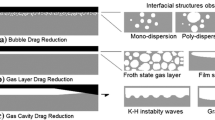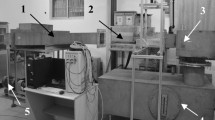Abstract
Micro-bubble is one of the most promising methods for reduction of skin friction drag. The injection of gas bubbles into a turbulent boundary layer may have multiple impacts on the turbulent flow structure. This work aims to understand the interaction between micro-bubbles and the turbulent boundary layer, especially the effect of the bubble layer thickness on the skin-friction drag reduction. Large eddy simulation was conducted for a turbulent boundary layer over a flat plate, injected with micro-bubbles, with a view to reduce skin-friction drag. The Reynolds number Re θ examined was 1430 based on the momentum thickness θ and free-stream velocity \( U_{\infty } \). A three-dimensional perturbation method was deployed to generate a turbulent boundary layer within a short distance of inflow.
Access this chapter
Tax calculation will be finalised at checkout
Purchases are for personal use only
Similar content being viewed by others
References
Degraaff DB, Eaton JK (2000) Reynolds-number scaling of the flat-plate turbulent boundary layer. J Fluid Mech 422:319–346
Ferrante A, Elahobashi S (2004) On the physical mechanisms of drag reduction in a spatially developing turbulent boundary layer laden with microbubbles. J Fluid Mech 503:345–355
Ferrante A, Elahobashi S (2005) Reynolds number effect on drag reduction in a microbubble-laden spatially developing turbulent boundary layer. J Fluid Mech 543:93–106
Madavan NK, Deutsch S, Merkle CL (1983) Reduction of turbulent skin friction by microbubbles. Tech Memorandum 10:1–38
Merkle CL, Deutsch S (1992) Microbubble drag reduction in liquid turbulent boundary layers. Appl Mech Rev 45(3):103–127
Sandham ND, Yao YF, Lawal AA (2003) Large-eddy simulation of transonic turbulent flow over a bump. Int J Heat Fluid Flow 24(4):584–595
Sanders WC, Winkel EW, Dowling DR, Perlin M, Ceccio SL (2006) Bubble friction drag reduction in a high Reynolds number flat plate turbulent boundary layer. J Fluid Mech 552:353–380
Acknowledgements
Financial support by Scientific Research Fund of Shenzhen Government through grant JCYJ20160531192108351 is gratefully acknowledged.
Author information
Authors and Affiliations
Corresponding author
Editor information
Editors and Affiliations
Rights and permissions
Copyright information
© 2019 Springer Nature Singapore Pte Ltd.
About this paper
Cite this paper
Cao, H.L., Guo, W., Li, X.H., Zhou, Y. (2019). Effect of Micro-bubbles on a Turbulent Boundary Layer. In: Zhou, Y., Kimura, M., Peng, G., Lucey, A., Huang, L. (eds) Fluid-Structure-Sound Interactions and Control. FSSIC 2017. Lecture Notes in Mechanical Engineering. Springer, Singapore. https://doi.org/10.1007/978-981-10-7542-1_21
Download citation
DOI: https://doi.org/10.1007/978-981-10-7542-1_21
Published:
Publisher Name: Springer, Singapore
Print ISBN: 978-981-10-7541-4
Online ISBN: 978-981-10-7542-1
eBook Packages: EngineeringEngineering (R0)




